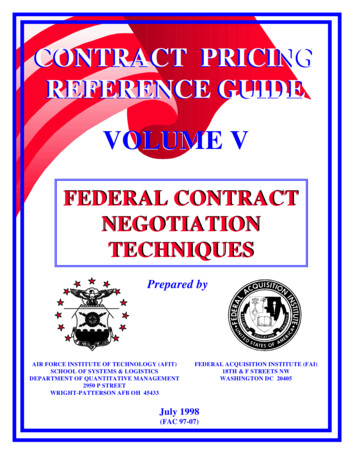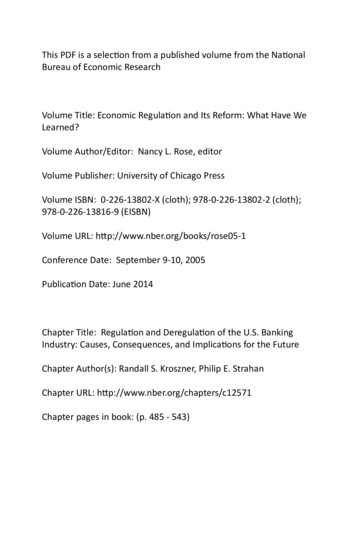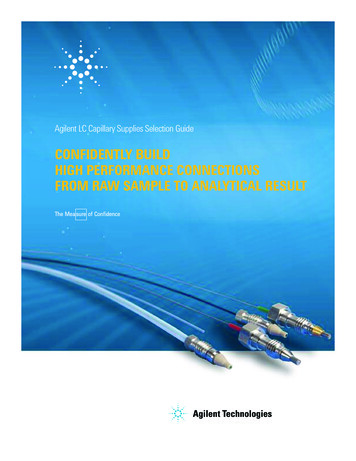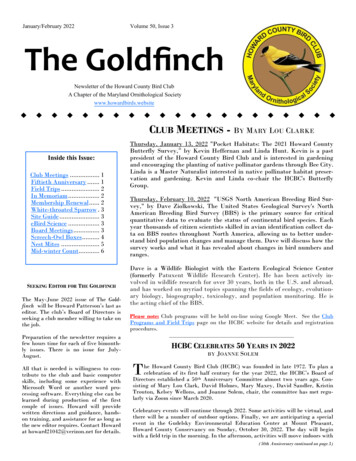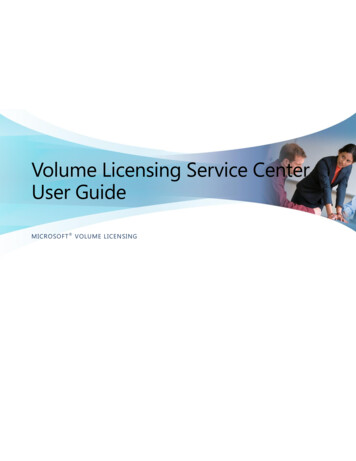
Transcription
Defense Acquisition UniversityContract Pricing Reference GuideVolume 4 – Advanced Issues (January 2021)24 Jan 2021 Draft (GWS)0
Table of Contents1.0 Chapter Introduction . 41.1 Matching Contract Type To Contract Risk . 41.2 Utilizing Fixed-Price Economic Price Adjustment Contracts . 121.3 Structuring and Applying Incentive Pricing Arrangements . 181.4 Structuring And Applying Award-Fee Pricing Arrangements . 341.5 Structuring Fixed-Price Redeterminable Pricing Arrangements . 392.0 Chapter Introduction . 482.1 Examining Indirect Cost Importance, Composition, And Allowability . 482.2 Identifying Pools And Bases For Rate Development. 562.3 Identifying Inconsistencies And Weaknesses In Rate Development. 632.4 Analyzing Estimated Rates . 702.5 Contract Forward Pricing . 782.6 Contract Billing . 802.7 Determining Final Indirect Costs . 87Chapter 3 Reviewing the Contractor’s Pricing and Accounting Practices . 983.1 Reviewing Accounting Systems. 983.1 Reviewing Accounting Systems. 993.2 Establishing The Government's Position On CAS Cost Impact Adjustments . 1043.3 Reviewing Cost Estimating Systems . 1123.4 Recognizing Potential Indicators Of Fraud And Other Wrongdoing . 117Chapter 4 Forecasting Cost Overruns . 1204.0 Chapter Introduction . 1214.1 Identifying And Analyzing Cost And Schedule Variances . 1224.1 Identifying And Analyzing Cost And Schedule Variances (cont) . 1264.2 Estimating Cost To Complete . 1454.3 Resolving Potential Cost Overruns . 148Appendix 4A, Earned Value Management System Guidelines . 151Chapter 5 Recognizing and Adjusting Defective Cost Pricing . 1535.0 Chapter Introduction . 1545.1 Identifying Possible Defective Pricing . 1615.2 Developing The Government Position On Price Adjustment . 1635.3 Completing Settlement Action . 169Chapter 6 Pricing Equitable Adjustments and Settlements . 1716.0 Chapter Introduction . 1726.1 Issues And Factors To Consider In Making Equitable Adjustments . 1726.2 Pricing Contract Changes . 1856.3 Other Situations Requiring Adjustment. 1896.4 Definitizing Undefinitized Contract Actions . 1961
6.5 Special Considerations For Pricing Claims . 198Chapter 7 Pricing Termination Settlements. 2017.0 Chapter Introduction . 2017.0 Chapter Introduction . 2027.1 Commercial Item Contract Termination for Convenience . 2027.2 Commercial-Item Contract Termination For Cause . 2037.3 Noncommercial-Item Fixed-Price Contract Termination For Convenience . 2047.4 Noncommercial-Item Fixed-Price Contract Termination For Default . 2107.5 Cost-Reimbursement Contract Termination For Convenience . 2127.6 Cost-Reimbursement Contract Termination For Default . 2147.7 Equitable Adjustment For Continued Portion Of A Fixed-Price Contract . 215Chapter 8 Conducting Cost Realism Analysis. 2168.0 Chapter Introduction . 2178.1 Evaluating Cost Realism . 2178.2 Considering The Uncompensated Overtime Effect On Cost Realism . 2248.3 Considering Cost Realism In Cost-Reimbursement Proposal Evaluation . 2288.4 Considering Cost Realism In Fixed-Price Proposal Evaluation . 234Chapter 9 Performing Financial Analysis . 2389.0 Chapter Introduction . 2399.1 Identifying Sources Of Financial Information . 2429.2 Identifying Key Financial Indicators . 2459.3 Applying Financial Indicators To Responsibility Decisions . 2509.4 Applying Financial Indicators To Contract Financing Decisions . 2559.5 Applying Financial Indicators To Performance Bond Decisions . 2689.6 Applying Financial Indicators To Progress Payment Administration . 2709.7 Applying Financial Indicators To Subordination Agreement Need Decisions . 2802
List of web links to the “Source” documents referenced in this CPRG Volume 4Use the following web page links for researching any specific references cited in this CPRG Volume 4 tothe Federal Acquisition Regulation (FAR), to the Defense Federal Acquisition Regulation Supplement(DFARS), to the Cost Accounting Standards (CAS), and to the other source documents listed below.1. Acquisition.gov FAR page: https://www.acquisition.gov/browse/index/far2. Acquisition.gov DFARS page: https://www.acquisition.gov/dfars3. CFR Title 48 Chapter 99, Cost Accounting Standards (CAS): https://www.acquisition.gov/chapter 994. DCAA Contract Audit Manual: anual/5. DCAA Pamphlet No. DCAAP 7641.90, Information for Contractors, January l6. DoD Instruction 7640.02: Policy for Follow-Up on Contract Audit s/DD/issuances/dodi/764002p.pdf7. Defense Contract Management Agency (DCMA) Earned Value Management Implementation licy/DCMA-INST-208.pdf?ver 2017-03-09-075739-8978. OMB Circulars, Federal tion-for-agencies/circulars/#procurement9. Bureau of Public Debt website: https://www.publicdebt.treas.gov/10. The 14 General Principles of Ethical Conduct, 5 C.F.R le/1072396/download11. DLA ASSIST Quick Search for “Data Item Descriptions”: https://quicksearch.dla.mil/qsSearch.aspx12. “DoD Forms” Management Program: https://www.esd.whs.mil/Directives/forms/13. GSA “Standard Forms”: https://www.gsa.gov/reference/forms#14. DAU Earned Value Management (EVM) Gold ence-(Gold-Card)15. Bureau of Labor Statistics: Producer Price Index: https://www.bls.gov/ppi/Bureau of Labor Statistics: Employment Cost Index: https://www.bls.gov/ncs/ect/16. The Securities and Exchange Commission (SEC): http://www.sec.gov/17. Dun and Bradstreet: www.dnb.com18. Moody's Investor Services: https://www.moodys.com/19. The International Directory of Corporate ss/guides/intldoccompany).html20. Standard and Poor: http://www.standardpoor.com/ratings/21. Thomas Register: http://www.thomasregister.com/22. The Value Line Investment Survey: http://www.valueline.com/23. The Risk Management Association (RMA) eStatement Studies: http://www.rmahq.org/RMA24. OMB Prompt Payment Regulations: . DoD Class Deviations issued by the Principal Director of Defense Pricing and Contracting, OSD:https://www.acq.osd.mil/dpap/dars/class deviations.html3
Chapter 1Establishing and Monitoring Contract Type1.0 Chapter IntroductionWhen used in this chapter, the terms "contract type" and "type of contract" refer to the contractcompensation arrangement. The contract compensation arrangement is the method of determining thedollars due to the contractor under the contract. In this chapter, you will learn about the development andapplication of common compensation arrangements:1.1 Matching Contract Type To Contract RiskPoints to Consider (FAR 16.103). Contract type selection is the principal method of allocating cost riskbetween the Government and the contractor. There is no single contract type that is right for everycontracting situation. Selection must be made on a case-by-case basis considering contract risk,incentives for contractor performance, and other factors such as the adequacy of the contractor'saccounting system. Your objective should be to select a contract type that will result in reasonablecontractor risk with the greatest incentive for efficient and economical contract performance. Selecting theproper contract type will make the work more attractive to more potential offerors, thereby increasingcompetition.As you match contract type to contract risk, consider the following: Identify available contract types; Consider acquisition method; Consider commerciality of the requirement; Consider cost risk associated with the contract action; Consider appropriate performance incentives; Consider the accounting system adequacy; and Document the selection decision.Identify Available Contract Types. The table on the following pages compares the most common type ofcontract arrangements. Most of those arrangements fit into two general categories fixed-price and costreimbursement, but labor-hour and time-and-materials contracts have characteristics of both: Fixed-Price (FAR subpart 16.2).Under a fixed-price contract, the contractor agrees todeliver the product or service required at a price not in excess of the agreed-to maximum.Fixed-price contracts should be used when the contract risk is relatively low, or definedwithin acceptable limits, and the contractor and the Government can reasonably agree ona maximum price. Contract types in this category include:oFirm fixed-price (FFP)oFixed-price contracts with economic price adjustment (FP/EPA)oFixed-price award-fee (FPAF)oFixed-price incentive (firm target) (FPIF)oFixed-price incentive (successive targets) (FPIS)oFixed-price contract with prospective price redetermination (FPPR)oFixed-ceiling-price contract with retroactive price redetermination (FPRR)oFirm fixed-price level of effort term contract (FFP/LOE)4
Cost-Reimbursement (FAR subpart 16.3).Under a cost-reimbursement contract, thecontractor agrees to provide its best effort to complete the required contract effort. Costreimbursement contracts provide for payment of allowable incurred costs, to the extentprescribed in the contract. These contracts include an estimate of total cost for thepurpose of obligating funds and establishing a ceiling that the contractor cannot exceed(except at its own risk) without the approval of the contracting officer.Contract types in this category include:oCost (CR)oCost-sharing (CS)oCost-plus-fixed-fee (CPFF)oCost-plus-award-fee (CPAF)oCost-plus-incentive-fee (CPIF)Labor-Hour (LH) and Time-and-Materials (T&M) (FAR subpart 16.6). There are twoother types of contract compensation arrangements that do not completely fit the mold ofeither fixed-price or cost-reimbursement contracts. Labor-hour and time-and-materialscontracts both include fixed labor rates but only estimates of the hours required tocomplete the contract. They are generally considered to most resemble costreimbursement contracts because they:oDo not require the contractor to complete the required contract effort within anagreed-to maximum price; andoPay the contractor for actual hours worked.Comparison of Major Contract TypesPrincipalRisk to beMitigatedUse WhenFirm FixedPrice tractorUnstablemarket pricesfor labor ormaterial overthe life of thecontract.Moderatelyuncertaincontract laboror materialrequirementsThe marketprices at riskare severableandsignificant.The riskstems fromindustry-widecontingenciesbeyond thecontractor'scontrol. TheA ceiling pricecan beestablishedthat covers themost probablerisks inherentin the nature ofthe work. Theproposed profitsharing formulawould motivatethe contractorassumes allcost risk. Therequirementis welldefined. Contractorsareexperiencedin meeting it. Marketconditionsare stable. FinancialFixed-PriceIncentive FirmTarget(FPIF)Fixed-Pricewith AwardFees(FPAF)Fixed-PriceContract withProspective PriceRedetermination(FPPR)Risk that theuser will not befully satisfiedbecause ofjudgmentalCosts ofperformance afterthe first yearbecause theycannot beestimated ards canbe fairly appliedby an Awardfee panel. Thepotential fee islarge enough toboth: Provide ameaningfulincentive.The Governmentneeds a firmcommitment fromthe contractor todeliver the suppliesor services duringsubsequent years.The dollars at riskoutweigh theadministrativeburdens of an FPRR.
Comparison of Major Contract TypesFirm FixedPrice ks areotherwiseinsignificantdollars at riskoutweigh theadministrativeburdens of anFP/EPA.ElementsA firm fixedprice for eachline item orone or moregroupings ofline items.A fixed-price,ceiling onupwardadjustment,and a formulafor adjustingthe price up ordown basedon: Establishedprices. Actual laboror materialcosts. Labor ormaterialindices.Contractoris Obligedto:Provide anacceptabledeliverable atthe time,place andprice specifiedin thecontract.ContractorIncentive(other thanmaximizinggoodwill) 1Generallyrealizes anadditionaldollar of profitfor everydollar thatcosts arereducedFixed-PriceIncentive FirmTarget(FPIF)Fixed-Pricewith AwardFees(FPAF)Fixed-PriceContract withProspective PriceRedetermination(FPPR)to control coststo and meetotherobjectives. Justify relatedadministrativeburdens.A ceiling priceTarget costTarget profitDelivery,quality, and/orotherperformancetargets(optional) Profit sharingformula A firm fixedprice. Standards forevaluatingperformance. Proceduresfor calculatinga fee basedonperformanceagainst thestandards Fixed-price forthe first period. Proposedsubsequentperiods (at least12 months apart). Timetable forpricing the nextperiod(s).Provide anacceptabledeliverable atthe time andplacespecified inthe contract atthe adjustedprice.Provide anacceptabledeliverable atthe time andplace specifiedin the contractat or below theceiling price.Perform at thetime, place,and the pricefixed in thecontract.Provide acceptabledeliverables at thetime and placespecified in thecontract at theprice establishedfor each period.Generallyrealizes anadditionaldollar of profitfor everydollar thatcosts arereduced.Realizes ahigher profit bycompleting thework below theceiling priceand/or izes anadditionaldollar of profitfor every dollarthat costs arereduced; earnsan additionalfee forsatisfying theperformancestandards.For the period ofperformance,realizes anadditional dollar ofprofit for everydollar that costsare reduced. 6
Comparison of Major Contract TypesFirm FixedPrice icalCommercialsupplies andservices.Long-termcontracts forcommercialsuppliesduring aperiod of highinflationPrincipalGenerallyNOTappropriatefor R&D.Must bejustified.ApplicationLimitationsin FARparts 16,32, 35, and52Variants1Firm Fixedprice Level ofEffort.Fixed-Pricewith AwardFees(FPAF)Fixed-PriceContract withProspective PriceRedetermination(FPPR)Production of amajor systembased on aprototypePerformancebased servicecontracts.Long-termproduction of spareparts for a majorsystem.Must bejustified. Mustbe negotiated.Contractormust have anadequateaccountingsystem. Costdata mustsupporttargets.Must benegotiated.MUST benegotiated.Contractor musthave an adequateaccounting systemthat supports thepricing e rminationGoodwill is the value of the name, reputation, location, and intangible assets of the firm.Comparison of Major Contract TypesCost-PlusIncentive-Fee(CPIF)PrincipalRisk to beMitigatedUse F)Cost (C) orCost-Sharing(CS)Time &Materials(T&M)Highly uncertain and speculative labor hours, labor mix, and/or material requirements (and otherthings) necessary to perform the contract. The Government assumes the risks inherent in thecontract -benefiting if the actual cost is lower than the expected cost-losing if the work cannot becompleted within the expected cost of performance.An objectiverelationship canbe establishedbetween the feeand suchmeasures ofperformance asactual costs,delivery dates,Objectiveincentive targetsare not feasiblefor critical aspectsof performance.Judgmentalstandards can befairly applied.Potential feeRelating fee toperformance(e.g., to actualcosts) wouldbe unworkableor of marginalutility.7 The contractorexpectssubstantialcompensatingbenefits forabsorbing partof the costsand/orforegoing feeNo other typeof contract issuitable (e.g.,because costsare too low tojustify an auditof thecontractor'sindirect
Comparison of Major Contract Award-Fee(CPAF)performancebenchmarks, andthe like.would provide ameaningfulincentive. Target cost Performancetargets(optional) A minimum,maximum, andtarget fee A formula foradjusting feebased on actualcosts and/orperformance Target cost Standards forevaluatingperformance A base andmaximum fee Procedures foradjusting fee,based onperformanceagainst thestandardsCost-PlusFixed-Fee(CPFF)Cost (C) orCost-Sharing(CS)or The vendor isa non-profitentity Target cost Fixed fee Target cost If CS, anagreement ontheGovernment'sshare of thecost. No feeContractoris Obligedto:Make a good faith effort to meet the Government's needs within the estimatedcost in the Schedule.ContractorIncentive(other thanmaximizinggoodwill)1Realizes a higherfee by completingthe work at alower cost and/orby meeting otherobjectiveperformancetargets.Realizes a higherfee by meetingjudgmentalperformancestandards.Realizes ahigher rate ofreturn (i.e.,fee divided bytotal cost) astotal costdecreases.If CS, shares inthe cost ofproviding adeliverable ofmutual benefitTypicalApplicationResearch anddevelopment ofthe prototype fora major system.Large scaleresearch study.ResearchstudyJoint researchwith educationalinstitutions.PrincipalLimitationsin FARparts 16,32, 35, 52The contractor must have an adequate accounting system. The Governmentmust exercise surveillance during performance to ensure use of efficientmethods and cost controls. Must be negotiated. Must be justified. Statutoryand regulatory limits on the fees that may be negotiated. Must include theapplicable Limitation of Cost clause at FAR 52.232-20 through FAR 52.232-23.8Time &Materials(T&M)expenses). A ceiling price A per-hourlabor rate thatalso coversoverhead andprofit Provisions forreimbursingdirect materialcostsMake a goodfaith effort tomeet theGovernment'sneeds withinthe ceilingprice.Emergencyrepairs toheating plantsand aircraftengines.Labor ratesmust benegotiated.MUST bejustified. TheGovernmentMUST
Comparison of Major Contract e(CPAF)Cost-PlusFixed-Fee(CPFF)Cost (C) orCost-Sharing(CS)Time &Materials(T&M)exerciseappropriatesurveillance toensure efficientperformance.VariantsCompletion orTerm.Labor Hour(LH)Consider Acquisition Method (FAR 14.104 and FAR 16.102,). The acquisition method selected for aparticular acquisition may limit the available choice of contract type: Simplified Acquisition. When using simplified acquisition procedures purchase orders arenormally firm fixed-price. You may use an unpriced order in certain situations when it isimpossible to obtain firm pricing prior to issuing the purchase order. Whenever you use anunpriced order, the order must include a dollar limit on the Government's obligation and thecontracting officer must follow-up to assure timely pricing. Sealed Bidding. When using sealed bidding procedures: oYou will normally use a firm fixed-price contract.oYou may use a fixed-price contract with economic price adjustment if the contractingofficer determines (in writing) what type of contract is necessary to protect the contractorand the Government against significant fluctuations in labor or material costs or toprovide for contract price adjustments in the event of changes in the contractor'sestablished prices.oYou must not use any other contract type.Negotiation. When using the negotiation procedures prescribed in FAR Part 15:oYou may use any contract type or combination of contract types that will promote the bestinterests of the Government, as long as you meet the specific limitations in FAR Part 16.oYou must not use any contract type not prescribed in the FAR unless authorized byagency regulation or a FAR deviation.Consider Commerciality of the Requirement (FAR 12.207). When acquiring a commercial item: You normally should use a firm fixed-price contract. You may use a fixed-price contract with economic price adjustment if the contracting officerdetermines (in writing) what type of contract is necessary to protect the contractor and theGovernment against significant fluctuations in labor or material costs or to provide for contractprice adjustments in the event of changes in the contractor's established prices. You must not use any other contract type in acquiring commercial items.Consider Cost Risk . Encourage contractors to accept reasonable cost risks of contract performance.However, requiring contractors to accept unknown or uncontrollable cost risk can endanger contractperformance, substantially reduce competition, and/or substantially increase contract price. To realisticallychoose the proper contract type to meet a specific contract situation, you must consider the properallocation of cost risk.9
Cost estimates, whether they are the offeror's proposed or the Government's recommended, are pointestimates. In all contracts involving forward pricing, the point estimate is a projection of what the estimatorbelieves is most likely to happen. Since things rarely happen exactly as predicted, there is usually somevariation between projected and actual cost. The greater the potential variability between the projectedand actual cost, the greater the cost risk.Cost ReimbursementFixed PriceQuantitative analysis techniques can provide invaluable information about the distribution of valuesaround the most likely future cost. For example, consider the confidence interval when your estimate isbased on sampling analysis and the prediction interval when your estimate is based on regressionanalysis. However, use this information wisely. If the variance is large, attempt to determine why theinterval is so large and what can be done to narrow it, before you select a contract type to share the risk.As a minimum, your appraisal of cost risk should consider two areas of particular concern, contractperformance risk and market risk. Performance Risk. Most contract cost risk is related to contract requirements and the uncertaintysurrounding contract performance. The lower the uncertainty the lower the risk. Therefore, yourappraisal of cost risk should begin with an appraisal of performance risk. For larger more complexcontracts, you will likely need assistance from other members of the Government AcquisitionTeam (e.g., representatives from the requiring activity, engineering staff, contracting, andprogram/project management). Areas that you consider should include:oStability and clarity of the contract specifications or statement of work;oType and complexity of the item or service being purchased;oAvailability of historical pricing data;oPrior experience in providing required supplies or services;oUrgency of the requirement;oContractor technical capability and financial responsibility; andoExtent and nature of proposed subcontracting.oThe figure below depicts what happens as the contract requirement becomes betterdefined.10
COST RISK AND CONTRACT TYPECost ConceptStudies oductionContractTypeVariedCPFFCPIF, FPIFCPIF, FPIF, orFFPFFP, FPIF,or FPEPAFFP, FPIF,or FPEPA LowWell-definedPerformance risk should be reduced from a high to a relatively low level, as the requirementprogresses from vague to well-defined and experience with the product increases.oResearch and development contracts generally have a rather high performance risk. This isdue to the factor of ill-defined requirements that arise from the necessity to deal beyond, orat least very near, the upper limits of current technology (i.e., "the state of the art").oFollow-on production contracts generally have a relatively low performance risk.Requirements are well known, there is a cost history to draw on, contractors haveexperience producing the product, etc. As performance risk changes, so should contract type. Note that cost-reimbursement, time &materials, or labor-hour contracts are generally associated with higher-risk requirements andfixed-price contracts are generally associated with lower-risk requirements. Market Risk. Changes in the marketplace will also affect contract costs. Preferred acquisitionpractice calls for forward pricing of contract efforts, because forward pricing provides a baselinewhich you and the contractor can use to measure cost or price performance against contract effort.oForward pricing requires the contracting parties to make assumptions about futurechanges in the marketplace. A volatile market will increase the cost risk involved incontract pricing, particularly when the contract period will extend several years. What willmaterial and labor cost two years from now? Will material shortages occur two years fromnow? In cases where these unknown costs are significant, contract period risk becomesan important consideration in selection of contract type.oFixed-price contracts with economic price adjustment, for example, are designedspecifically to reduce this risk for contractors.Consider Appropriate Performance Incentives (FAR 16.103(b)). Select the contract type (or combinationof types) that will appropriately motivate contract performance. When the risk involved is minimal or can be predicted with an acceptable degree of certainty, usea firm fixed-price contract, because it best utilizes profit to motivate efficient contract performanceand cost control. When
Fixed-price contracts should be used when the contract risk is relatively low, or defined within acceptable limits, and the contractor and the Government can reasonably agree on a maximum price. Contract types in this category include: o Firm fixed-price (FFP) o Fixed-price contracts with economic price adjustment (FP/EPA)




